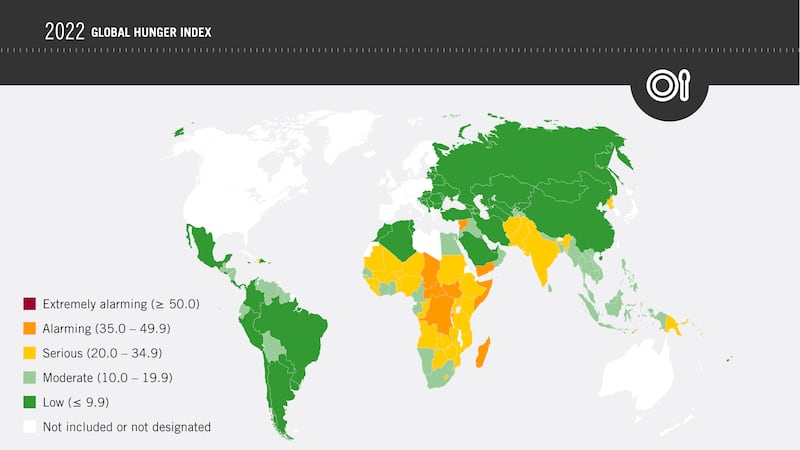World hunger levels are reaching catastrophic proportions, with 44 countries suffering with serious or alarming levels of hunger, according to the 2022 Global Hunger Index.
The study, which uses data from 136 countries, cites the Ukraine war as one of the reasons why nine nations, including Somalia where famine is imminent, and Yemen, have alarming levels of hunger.
The other countries with “alarming” levels of hunger in 2022 are Chad, Democratic Republic of Congo, Madagascar, Central African Republic, Syria, Burundi and South Sudan.
An additional 35 countries, including Pakistan, India and Afghanistan, were found to have serious levels of hunger in the latest index jointly published by Irish humanitarian organisation Concern Worldwide and German charity Welthungerhilfe.
The index shows south Asia has the world’s highest levels of child stunting (low body weight to height) and child wasting (malnourished or emaciated), while areas of Africa south of the Sahara have the highest levels of undernourishment and child mortality rates.

“Progress made to tackle world hunger has largely halted,” said Concern Worldwide chief executive Dominic MacSorley. “It’s sobering that 828 million people are undernourished today and many of them are children who should not be suffering in a world with so much food and wealth.
“The toxic cocktail of conflict, climate change and the Covid-19 pandemic had already left millions exposed to food price shocks and vulnerable to further crises,” he said. “The war in Ukraine – with its knock-on effects on global supplies and prices for food, fertiliser and fuel – is turning a crisis into a catastrophe. It is critical to act now to rebuild food security on a new and lasting basis. Failure to do so means sleepwalking into the catastrophic and systematic food crises of the future.”
The index recommendations include a call for governments to enshrine in law “the right to food” for all people. It also forecasts that by 2030 (the year that the UN has set as the target to end world hunger under its Sustainable Development Goal 2) there will still be hundreds of millions of people experiencing hunger.
“While we may not be able to end hunger by then, we can stop it heading in the wrong direction,” said Concern’s head of advocacy Réiseal Ní Chéilleachair. “The number of shocks people are experiencing means more effort is needed to increase global food, nutrition and livelihood security. The interdependency of the food system is evident in how shocks in one country can have a direct impact on the purchasing power and food consumption of families in another,” she said.
A separate report has found record high temperatures this year – which are fuelling catastrophes in Somalia, Pakistan and other parts of the planet – “foreshadow a future with deadlier, more frequent, and more intense heat-related humanitarian emergencies”.
Released ahead of the UN climate conference Cop27, the Extreme Heat: Preparing for the Heatwaves of the Future report concludes that with climate disruption making heatwaves ever more dangerous, “aggressive steps must be taken now to avert potentially recurrent heat disasters”.
“As the climate crisis goes unchecked, extreme weather events, such as heatwaves and floods, are hitting the most vulnerable people the hardest,” says Martin Griffiths, UN undersecretary-general for humanitarian affairs. “Nowhere is the impact more brutally felt than in countries already reeling from hunger, conflict and poverty.”
The report – published jointly by the UN Office for the Coordination of Humanitarian Affairs and the International Federation of Red Cross and Red Crescent Societies (IFRC) – offers concrete steps that humanitarians and decision-makers can take to mitigate extreme heat’s worst effects.
This year has already seen communities across north Africa, Australia, Europe, south Asia, and the Middle East suffocate under record-high temperatures. Most recently the western United States and China have buckled under severe heat.
In coming decades heatwaves are likely to meet and exceed “human physiological and social limits” in regions such as the Sahel, the Horn of Africa and south and southwest Asia. “Extreme heatwaves in these regions, where humanitarian needs are already high, would result in large-scale suffering and loss of life, population movements and further entrenched inequality,” it predicts.
“The climate crisis is intensifying humanitarian emergencies all around the world. To avert its most devastating impacts we must invest equally on adaptation and mitigation, particularly in the countries most at risk,” said IFRC secretary general Jagan Chapagain. “At Cop27 we will urge world leaders to ensure this investment reaches local communities that are on the frontline of the climate crisis. If communities are prepared to anticipate climate risks and equipped to take action, we will prevent extreme weather events from becoming humanitarian disasters.”





